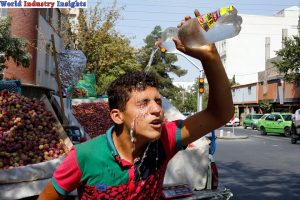Iran Heatwave Crisis: As relentless summer heat continues to grip southern Iran, Sepideh, a physician, and her dentist husband endure the sweltering days, venturing out of their home only for work in the mornings and for groceries when supplies are depleted. With temperatures soaring to a staggering 57 degrees Celsius (approximately 135 degrees Fahrenheit) on her car’s dashboard thermometer, Sepideh humorously posted on Instagram, “Only 57 degrees!”
Despite the privilege of having air-conditioning at home, a luxury not accessible to all, a harsh reality grips much of southern Iran. Poverty and extreme heat are crushing the region, where vast deserts, coupled with the humidity from the nearby Persian Gulf, render the area prone to severe heatwaves and droughts, further exacerbated by climate change.
As the Iranian economy stagnates and inflation reaches double digits, air-conditioning becomes an unaffordable luxury for many, trapping people in indoor jobs with no escape from the relentless heat.
The chronic mismanagement of water resources has left taps running dry or spouting salty water across the country, particularly in the arid south. Iran’s water woes have reached a dire state of “water bankruptcy,” where the consumption surpasses supply, leaving no viable means of reversing the depletion.
While droughts intensify, groundwater and reservoirs dry up, leaving rural communities struggling to afford water, which is often trucked in or purchased from stores. Protests sparked by water shortages erupted in Isfahan and Khuzestan Province in 2021, signaling growing discontent with the government’s inability to address the scorching heat.
Government officials have forewarned that the southeastern province of Sistan and Baluchistan, already burdened with poverty, will entirely run out of municipal water by September, signaling an impending catastrophe.
Also Read: Heatwave Crisis: American Industries Grapple with Economic Turbulence
The situation in Bandar-e Dayyer, a southern coastal city, paints a grim picture. Salty and undrinkable tap water has become the norm this summer, pushing residents to take matters into their own hands as the government remains unresponsive.
Amid this adversity, people in southern Iran have learned to adapt to the sweltering heat and suffocating humidity. They limit outdoor activities to early mornings or late evenings, seek refuge near rivers and canals to meet friends, and cope with limited access to water during scorching days.
In certain areas, humidity merges with high temperatures, leading to a heat index of a staggering 152 degrees Fahrenheit, beyond human tolerability. Schools and offices have limited their hours, and workplaces have become unbearable for many laborers toiling in outdoor conditions.
The necessity to hide indoors with air-conditioning becomes a simple yet unattainable solution for those grappling with poverty.
The ancient Persians may have pioneered innovative windcatchers to cool buildings, but modern-day Iran heavily relies on air-conditioning, leaving many trapped in their homes, struggling to endure the extreme temperatures.
As the unrelenting heat persists, Iranians in the south find themselves conf[ez-toc]ined indoors, yearning for respite from the blistering sun and longing for a future where access to water and relief from the scorching heat become a reality.”
Our Reader’s Queries
What country is shutting down due to heat?
Iran is currently experiencing a national shutdown due to the soaring temperatures. The authorities have hinted that the national holiday may be extended further.
Why is it so hot in Iran?
Iran’s climate is hot and dry, with long, scorching summers and brief, cool winters. The country’s location between the arid Arabian desert and the humid eastern Mediterranean area influences its climate. This results in a unique climate that is both dry and hot, making it a challenging environment to live in. Despite this, Iran’s people have adapted to their surroundings and continue to thrive in this unique climate.
What is the hottest temperature recorded in Iran?
Basrah, a city in southern Iraq, experienced scorching temperatures similar to those in Ahvaz, Iran. In fact, Ahvaz holds the record for Asia’s highest temperature, reaching a staggering 129 degrees (54 Celsius) in 2017. Recently, the Persian Gulf has been delivering particularly high heat indexes, making the already hot weather even more unbearable.
What is the extreme heat in Iran?
Several cities in southern Iran are currently experiencing an unprecedented heatwave. According to state media, temperatures in the city of Ahvaz have soared to over 123 degrees Fahrenheit (51 Celsius) this week. The scorching heat has already caused significant discomfort and inconvenience for residents in the affected areas.


